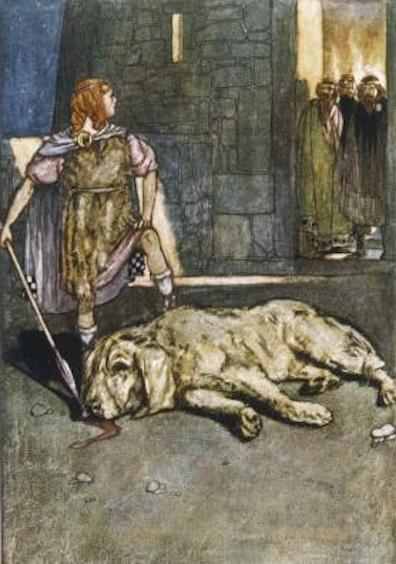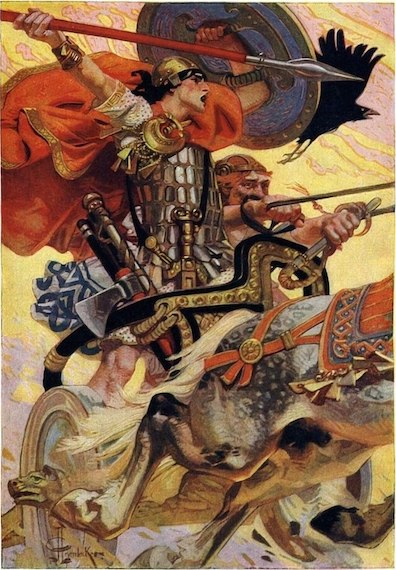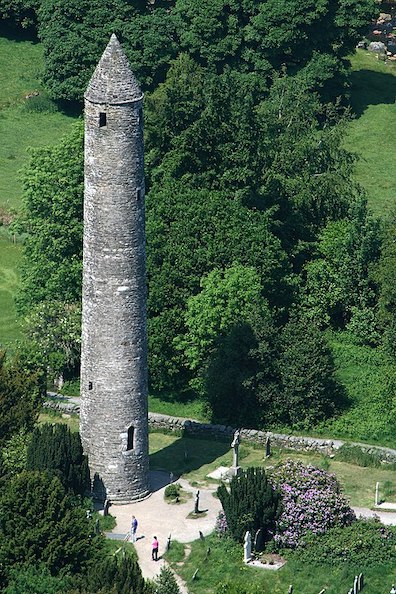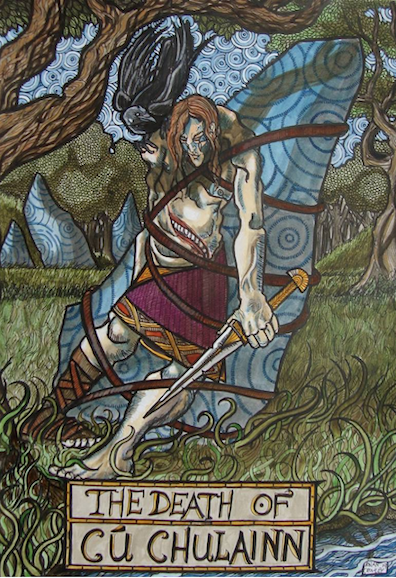The first of the "
Irish
heroes and heroines of antiquity" depicted on the stones,
"
Cuchulin," is surely one inspiration for Joyce's "
broadshouldered
deepchested stronglimbed frankeyed redhaired freelyfreckled
shaggybearded widemouthed largenosed longheaded deepvoiced
barekneed brawnyhanded hairylegged ruddyfaced sinewyarmed hero."
Cú Chulainn, the semidivine warrior of the Ulster Cycle, is the
archetypal ancient Irish hero. He was born Sétanta, but after
being attacked by the smith Culain's fierce guard dog and
killing it, he offered to take its place as a guard and became
the Cú (Hound) of Chulainn (or Chulain, Chulin, Culain, or
Culann.) Like Achilles in Greek mythology, he is an irresistibly
strong warrior who becomes possessed by frenzy in battle,
cutting bloody swaths through armies in his chariot and
defeating opponent after opponent in single combat.
Slote, Mamigonian, and Turner note that "Irish mythological
heroes are typically accompanied by dogs." They quote from
Standish O'Grady's
History of Ireland (1881): "The
heroic age of Ireland is, in fact, the age of the Hounds; and
surely no nobler and more touching type of the heroic temper
could be selected than this magnanimous brute. [...] The hounds
of the third century of our era, the age of the Fenian heroes,
are dogs—the comrades of the warriors" (187).
Thus the Citizen is accompanied by a large dog—"that bloody
mangy mongrel, Garryowen." The narrator says, "I'm told for a
fact he ate a good part of the breeches off a constabulary man
in Santry that came round one time with a blue paper about a
licence," and the end of
Cyclops shows Garryowen rushing
to rid the Citizen of another enemy. But the parody also recalls
the act that gave Cú Chulainn his name, when the hero
disciplines his dog "
from time to time by tranquilising blows
of a mighty cudgel rudely fashioned out of paleolithic stone."
Like Polyphemus he is enormous, measuring "several ells" across
the shoulders (the ell is an English linear measure of 45
inches, well more than a meter), with "rocklike mountainous
knees," nostrils large enough for birds to nest in, and eyes the
size of cauliflowers. "A powerful current of warm breath"
streams from his cavernlike mouth, and his heartbeat is as
seismic: "
the loud strong hale reverberations of his
formidable heart thundered rumblingly causing the ground, the
summit of the lofty tower and the still loftier walls of the
cave to vibrate and tremble." Here again there is an echo
of Cú Chulainn. Standish O'Grady writes that "like the
sound of a mighty drum his heart beats" (232).
Slote and his collaborators also cite inspirations in P. W.
Joyce's
Social History of Ancient Ireland (1913) for
details of the hero's clothing. One item of ancient Irish garb
was "A large cloak, generally without sleeves, varying in
length, but commonly covering the whole person from the
shoulders down.... sometimes it was a formless mantle down to
the knees; but more often it was a loose though shaped cloak
reaching to the ankles" (2.193-94). The hero of the parody has a
"
long unsleeved garment of recently flayed oxhide reaching to
the knees."
These cloaks were made from cloth, not leather, but Joyce
augments the air of primitive savagery by draping his hero in
"recently flayed oxhide," and augments the impression by giving
him "brogues of salted cowhide laced with the windpipe of the
same beast." He wears also "
a loose kilt," which P. W.
Joyce notes "must have been very much worn both by ecclesiastics
and laymen" (2.203), and "
trews of deerskin," also
mentioned in the history: "Leggings of cloth, or of thin soft
leather, were worn, probably as an accompaniment to the kilt"
(2.209). (According to the
OED, trews are "Close-fitting
trousers, or breeches combined with stockings, formerly worn by
Irishmen and Scottish Highlanders.")
The
Social History of Ancient Ireland observes that "A
girdle or belt (Ir.
criss) was commonly worn round the
waist, inside the outer loose mantle," and "The girdles of
chiefs and other high-class people were often elaborately
ornamented" (2.212). Joyce's hero has "
a girdle of plaited
straw and rushes"—the familiar Irish
súgán—and it
is hung with carved stone images of other heroes. He wears socks
"
dyed in lichen purple," an adaptation of the information
that "Purple cloaks, purple flowers, and purple colour in
general, are very often mentioned in Irish writings.... Purple
dyestuff was obtained from a species of lichen" (2.216-18).
The superhuman figure of the parody, then, is indebted both to
scholarship on ancient Irish dress and popular mythological
accounts of ancient Irish warriors like Cú Chulainn—both of
which were required reading for enthusiasts of the Irish
Literary Revival. Joyce adds to them one final marker of
echt
ancient Irishness, the "
round tower" at whose base the
hero sits. Round towers were medieval stone buildings of a
distinctively Irish type. Usually built next to churches or
monasteries, they served as bell towers but also as defensive
fortifications in times of trouble. Nearly 20 of them remain in
good condition, out of perhaps 120 built throughout the country.
Seeking a heroic symbol of national identity for the Revival,
William Butler Yeats featured Cú Chulainn in five short plays
and some poems. Lady Gregory retold some of his legends in
Cuchulain
of Muirthemne (1902), toning down their
violence and making him the kind of hero children could
admire. But Joyce was uninterested in reviving Celtic
myths and unimpressed by muscular fighters, so he presents his
larger-than-life hero in a distinctly mock-heroic spirit. The
powerfully built Citizen can only be diminished by such greatly
exaggerated praises. By contrast, the puny newspaper vendor
Davy
Stephens used comedy to his advantage when he archly
modeled himself on an ancient hero:
His exterior is peculiar but prepossessing.
Standing a little below the usual height for the proverbial
Irishman, this point is quickly lost sight of in a deep well
of wit, not yet completely sounded, beaming forth in his eyes.
No one can say whether it is in the merry glance of his eye or
in the quick repartee that issues from his lips, never for a
moment sealed, that Davy’s fortune lies. The corners of his
mouth are turned up in a perpetual smile which his clean
shaven chin tends to emphasise. His hair hangs down over his
shoulders in long strings, reminding one of that of Ulysses
when tossed by the sea at the feet of the charming Nausicaa,
and the fresh breezes of the Channel have reduced his
complexion to a compromise between red and brown.... Add to
these particulars a fine rich brogue and the man is complete.



